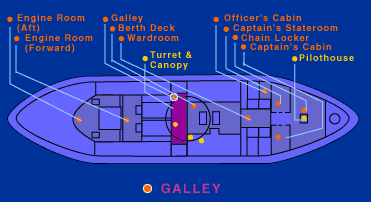 |

|

|
 |
|
Intro |
Galley |
Deck |
Canopy |
Wardroom |
Officer's Cabin |
Captain's Cabin |
Captain's Stateroom |
Turret |
Pilothouse |
Chain Locker |
Berth Deck |
Engine Room - Forward |
Engine Room - Aft Galley The area aft of the midships bulkhead was almost entirely devoted to the Monitor's machinery. Two large, oval iron hatchways offered access to this area through the midships bulkhead. When secured, these hatches made for an airtight seal between the living and the engineering spaces of the ship. This tight seal was necessary to maintain the draft to the boilers provided by the engine room's belt-driven blowers. The first area aft of the bulkhead was the ship's galley. A large iron stove backed up to the Monitor's boilers, while various racks and shelves held cookware and utensils. In the overhead, one found the gears and the steam engines that revolved the Monitor's gun turret. Unlike that in the forward areas of the ship, the floor here was not made of wood. The fire risk in this part of the ship was great, so the Monitor's builders installed a diamond-pattern, cast-iron floor plate throughout the engineering and galley areas. The galley also held the crew's and officers' "water closets." A pair of below-waterline flushing heads could be found on the starboard side for the enlisted men, while another stood on the port side for the officers. The Monitor is one of the first vessels credited with utilizing below-waterline flushing toilets, the operation of which took a little getting used to. One account notes that the Monitor's surgeon was propelled off his seat on a geyser of water because he operated the valves in the wrong order. Conditions below deck were deplorable during the summer months. Temperatures noted in logbook entries neared 100°F in the berthing areas even with the ironclad anchored in the shade. During June and July, temperatures in the galley topped 130°F on an almost daily basis, while in the engine room, they approached an unbearable 150°F. Behind the galley stove reared the Monitor's pair of Martin boilers. The 14-by-9-foot boilers provided the steam necessary to operate all of the ship's various engines and pumps. The rest of the port and starboard sides aft of the galley were partitioned for coal bunkers. A narrow passageway just barely two feet wide led between the boilers and the coal bunkers. A sailor had to be sure-footed navigating this walkway, for one misplaced step could land him against the side of a scaldingly hot boiler. Tour the Monitor | Behind the Scenes Eyewitness to the Battle | Steam Machine | Resources Transcript | Site Map | Lincoln's Secret Weapon Home Previous Sites | Adventures | Join Us/E-mail | TV/Web Schedule Teachers | Site Map | Search | Shop | To print PBS Online | NOVA Online | WGBH © | Updated October 2000 |
||